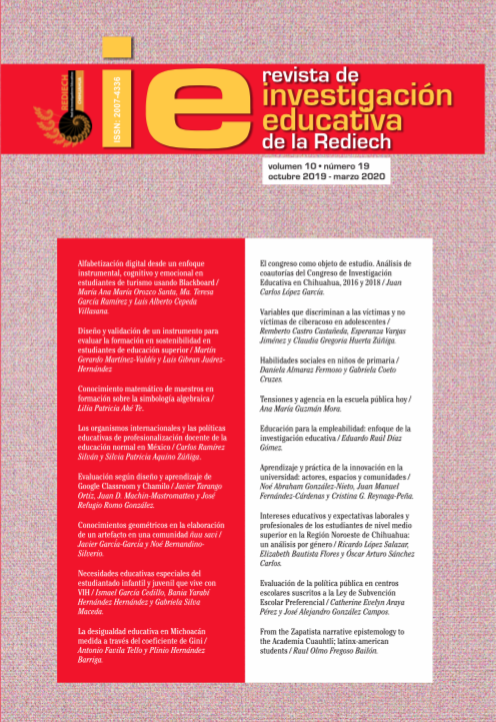Educational interests, occupational and professional expectations of bachelor’s degree in Northwest Region of Chihuahua: A gender analysis
DOI:
https://doi.org/10.33010/ie_rie_rediech.v10i19.720Keywords:
gender, educational interests, labor and professional expectations, students of the upper middle school level, Northwestern ChihuahuaAbstract
In this article is exposed and analyzed the results of a survey applied between 2013 and 2014, to students who attended the last year of the upper middle school level in the region known as Northwest Chihuahua (this region includes the municipalities of Ascension, Buenaventura, Janos, Galeana, Casas Grandes, Nuevo Casas Grandes, Zaragoza and Gomez Farias). The objective of this work was to know the educational interests, the labor and professional expectations according to the gender. The results obtained allowed to identify the tendencies of professional choice, the economic-social differences and even aspirational. It emphasizes that young people receive mostly the support of parents, but it is interesting the answers expressed in relation to continue with the university studies, because while the men do not assign great importance to obtain a grade, women consider a life plan that includes graduating from a bachelor’s degree and continue their graduate courses. However, labor expectations of women measured through wage income tend to be lower than men, since it does not rise to more than five thousand pesos per month. It is concluded that gender influences in a decisive way in the choice of the bachelor’s degree program, the labor and professional expectations.
References
Banco Mundial. (2019). Gasto público en educación, total (% en PIB). Instituto de Estadística de la Organización de las Naciones Unidas para la Educación, la Ciencia y la Cultura (UNESCO). Recuperado de https://datos.bancomundial.org/indicador/SE.XPD.TOTL.GD.ZS
Bautista-Flores, E., Sánchez-Carlos, O. y López Salazar, R. (2013). Encuesta tendencias educativas entre jóvenes bachilleres de la región noroeste de Chihuahua. Chihuahua: Universidad Autónoma de Ciudad Juárez, División Multidisciplinaria Nuevo Casas Grandes, Chihuahua.
Gobierno del Estado de Chihuahua. (2008). Análisis descriptivo de la estructura económica e industrial del estado de Chihuahua. Centro de Investigaciones Sociales y Económicos.
Gobierno del Estado de Chihuahua. (2009). Análisis descriptivo de la estructura económica e industrial del estado de Chihuahua. México. Recuperado de http://chihuahua.gob.mx/atach2/codech/uploads/AN%C1LISIS%20DESCRIPTIVO%20DE%20LA%20ESTRUCTURA%20ECON%D3MICA%20E%20INDUSTRIAL%20DEL%20ESTADO%20DE%20CHIHUAHUA.pdf
Haq, M. (1999). Reflections on human development. Oxford University Press, Delhi.
Instituto Nacional para la Evaluación de la Educación (INEE). (2018). Panorama educativo de México. Indicadores del Sistema Educativo Nacional 2017. Educación básica y media superior. México. Recuperado de http://publicaciones.inee.edu.mx/buscadorPub/P1/B/116/P1B116.pdf
Lewin, K. (1993). Education and development the issues and the evidence (education research paper n. 6). Centre for International Education University of Sussex.
López, R. y Bautista, E. (2015). Expectativas educativas y laborales de estudiantes de bachillerato en la región noroeste de Chihuahua. En Chihuahua hoy. Ciudad Juárez: Universidad Autónoma de Ciudad Juárez. Recuperado de http://elibros.uacj.mx/omp/index.php/publicaciones/catalog/download/57/51/603-1?inline=1
Organización para la Cooperación y el Desarrollo Económicos (OCDE). (2015). Panorama de la educación 2015, México. Nota país. Recuperado de https://www.oecd.org/mexico/Education-at-a-glance-2015-Mexico-in-Spanish.pdf
Secretaría de Educación Pública (SEP). (2012). Sistema educativo de los Estados Unidos Mexicanos. Principales cifras. Ciclo escolar 2011-2012. Recuperado de http://www.sep.gob.mx/work/models/sep1/Resource/1899/3/images/principales_cifras_2011_2012.pdf.
Serdyukov, P. (2017, abril 3). Innovation in education: what works, what doesn’t, and what to do about it? Journal of Research in Innovative Teaching & Learning, 10(1), 4-33. https://doi.org/10.1108/JRIT-10-2016-0007.
Sistema Nacional de Información Estadística Educativa. (2016). Escuelas, alumnos y maestros, según nivel educativo. México: Secretaría de Educación Pública. Recuperado de http://www.snie.sep.gob.mx/descargas/estadistica/SEN_estadistica_historica_nacional.pdf
UNESCO. (2007). Compendio mundial de la educación. Comparación de estadísticas de la educación en el mundo. Quebec, Canadá: Instituto de Estadística de la UNESCO. Recuperado de https://www.oei.es/historico/quipu/compendio_educacion2007.pdf
UNESCO. (2017). Informe de seguimiento de la educación en el mundo, 2016: la educación al servicio de los pueblos y el planeta: creación de futuros sostenibles para todos. París. Recuperado de https://unesdoc.unesco.org/.../attach_import_784bebdd-f932-4a42-bfe2-7ab6ccf12311
Villarreal, E. (2018). Endogeneidad de los rendimientos educativos en México. Perfiles Latinoamericanos, 26(51), 265-299. https://dx.doi.org/10.18504/pl2651-011-2018




















